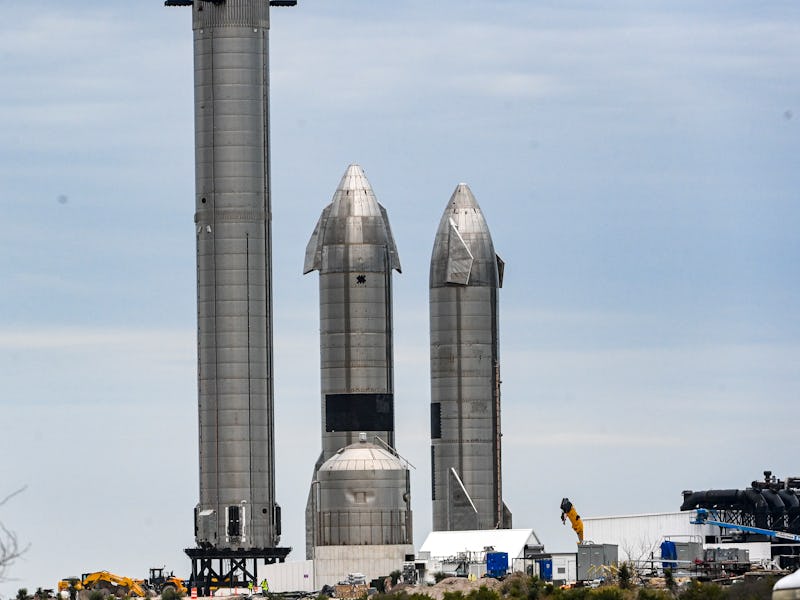Look: SpaceX teases orbital test flight with dramatic Starship images
Long time coming.

Not long ago, SpaceX passed their Programmatic Environmental Assessment (PEA) with the FAA, though many corrective actions were recommended. With this hurdle in its rearview mirror, SpaceX is busy preparing the Starship and Super Heavy prototypes for their orbital test flight. On Saturday, July 2, the company posted pictures on its Twitter feed that showed the Starship (SN24) and Super Heavy booster (BN7) outfitted with all the Raptor engines — 33 Raptors for the BN7, 6 for SN24 — that will take them to space.
The photos of the BN7s engines (left) show its 33 Raptor 2 engines — optimized for sea level — arranged in two concentric circles with three clustered in the center. On the other hand, the Starship’s complement of engines includes three Raptor 2s arranged around an outer ring and three Raptor Vacuum engines (optimized for space) arranged in a cluster in the center.
This represents the most recent configuration for the entirely reusable, super-heavy launch system, which will be fully stacked for the orbital flight test.
What is the orbital test?
Based on previous filings with the FCC, this test will see the BN7 booster and SN24 launch together from the Spaceport and separate about 170 seconds into flight. The booster element will then perform a soft landing at sea about 30 kilometers (20 mi) from the Texas shoreline.
The SN24 will reach an altitude of 200 kilometers (~125 miles) before performing a targeted soft splashdown roughly 100 kilometers (62 miles) off the coast of the Hawaiian island of Kauai. The total flight time will last about 90 minutes and will (if successful) validate the launch system for several mission profiles.
Not the least of these is the deployment of Starlink V2.0 satellites, which the Starship will dispense in Low Earth Orbit (LEO) like a “Pez dispenser.”
As Musk related in a recent interview with Everyday Astronaut, the Starship is absolutely essential to the creation of Starlink’s next-generation satellite constellation:
“It’s the only thing that can carry the Starlink Two satellites. We’ve already produced the first, and we have on-site the first Starlink Two, and it’s seven meters long (23 ft). [The] Falcon [9] has neither the volume nor the mass-to-orbit capability required for Starlink Two. So even if we shrunk the Starlink Two down, the total upmass of Falcon is not nearly enough to do Starlink Two.”
Starship and Super Heavy: To the Moon
Beyond sending satellites to LEO, the Starship and Super Heavy are vital to Musk’s long-term vision of flying cargo and passengers to Mars. In accordance with this vision, Musk hopes to rapidly construct Starships at the company’s Starports in Texas and Florida (at Cape Canaveral) and rapidly stack them using the “Mechazilla” launch towers.
This way, SpaceX can optimize turnaround time with its launches and accommodate regular flights to Mars — each of which will carry 100 passengers or 100 Megatons of cargo.
The variant of the Starship will also act as the Human Landing System (HLS) for NASA’s Artemis III mission, which is currently scheduled to launch by 2025. As part of the Artemis Program, this mission will be the first time astronauts have landed on the Moon since the Apollo Era.
As per the mission architecture that NASA recently shared, the Space Launch System (SLS) will send an Orion spacecraft and its four-person to space while the Starship HLS (or Lunar Starship) launches separately and refuels in orbit.
The Orion spacecraft and its crew will then rendezvous in lunar orbit, where they will transfer aboard the HLS and land on the lunar surface. Musk has also indicated that he hopes to use the Starship to send payloads and crews to the Moon to support future Artemis missions and NASA’s long-term goal of establishing a “sustained program of lunar exploration.”
Alas, the Starship and Super Heavy launch system’s ultimate goal is the creation of a self-sustaining city on Mars.
While a date has not been announced for the orbital flight test, Musk stated back in June (shortly after the FAA issued its report) that SpaceX would be ready to go sometime this month. Needless to say, many people are eagerly waiting for his company to deliver!
This article was originally published on Universe Today by Matt Williams. Read the original article here.
This article was originally published on